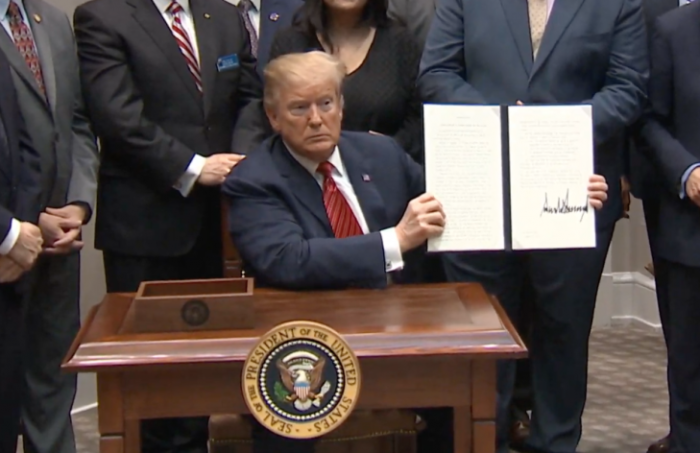WASHINGTON—President Donald Trump has signed an executive order aimed at lowering the rate of veteran suicides.
The order—the President’s Roadmap To Empower Veterans and End a National Tragedy of Suicide—creates a Cabinet-level task force led by VA Secretary Robert Wilkie that will work to develop a national suicide prevention roadmap over the next year.
“Veteran suicide is a tragedy of staggering proportions,” Trump declared at the signing ceremony last month. “There are more than 6,000 veteran suicides per year. The suicide rate among veterans is 1.5 times greater than that for nonveteran adults. And the suicide rate for post-9/11 soldiers has increased significantly over the last 10-year period. The task force will create a comprehensive national public health roadmap that brings together federal and local government along with private sector partners to improve the quality of life for our veterans and turn the tide on this terrible crisis.”

The task force will be made up of the secretaries of VA, Defense, Health and Human Services and Homeland Security, and its mandate is expansive: to develop a comprehensive public health plan for helping veterans “pursue an improved quality of life and end the national tragedy of veteran suicide.”
That plan includes the development of a national research strategy incorporating both public and private sector stakeholders intended to improve understanding of the underlying factors leading to suicide with the goal of earlier identification of risk factors and subsequent intervention. The roadmap also will include a proposal for how to equip state and local governments with the resources they need to provide services to veterans’ communities.
“The administration’s roadmap will help create a national and local ecosystem that cultivates active engagement with each veteran, rather than a passive system wherein the onus for engagement is placed on veterans,” the executive order states.
The task force has one year to develop the roadmap.
While legislators agree with increasing the focus on veteran suicide, some wonder whether VA and other agencies are doing enough with the resources and information they already possess.
“We have questions about how the White House plans to implement this initiative at the same time that previous efforts to address veterans suicide remain outstanding,” declared House VA Committee Chair Rep. Mark Takano (D-CA). “Sadly, too many barriers to access remain for at-risk veterans, even though VA is a leader in research and is unrivaled in providing mental health services for veterans. We must press VA to utilize effective treatment strategies driven by evidence based outcomes and strengthen oversight over community partnerships and grants even as the department operates under limited budgetary constraints.”
Senate Legislation
On the Senate side, legislators have introduced a bipartisan bill that bolsters VA’s current efforts while simultaneously dovetailing with PREVENT. On March 13, Senators Jon Tester (D-MT) and Jerry Moran (R-KS) introduced the Commander John Scott Hannon Veterans Mental Health Care Improvement Act. Named after a retired Navy commander who died by suicide in February 2018, the 18-part bill includes provisions designed to increase VA’s mental health workforce, improve veterans’ access to VA resources, make resources available to non-VA organizations that provide mental healthcare to veterans, and help servicemembers transitioning from active duty to VA healthcare.
“One veteran lost to suicide is one too many, and Congress has an obligation to those who have bravely served our nation to fix this tragedy,” said Moran. “As our servicemembers transition to civilian life, we can ease this difficult process by removing barriers to mental healthcare that our veterans need. This bipartisan legislation, which complements the President’s PREVENTS initiative, would expand efforts in local communities to provide veterans with mental healthcare, would allow the VA to hire and train more professionals in this field and would develop innovative methods for the delivery of this care.”
In addition to providing incentives for more mental health providers to come to VA, the bill includes a grant program for non-VA mental healthcare organizations. The bill requests $5 million be made available for such grants in 2021, with the amount increasing to $10 million in 2022 and $15 million in 2023. The legislation also would expand the use of alternative therapies, such as yoga, meditation, acupuncture and equine therapy.
The bill also dovetails with another executive order—one Trump signed in January 2018 charging VA and DoD with working together to create a plan that would provide all servicemembers access to VA healthcare for a year following their discharge, regardless of whether their condition has been proven to be service-connected. That one-year of automatic enrollment is one of the provisions of the bill.
The legislation also targets perceived weaknesses in VA’s accountability and transparency. One provision directs VA to set goals for and study the effectiveness of the VA’s suicide prevention and mental health media outreach. VA came under fire in December when it was shown that the department had used only a small percentage of its budget for suicide prevention outreach in FY 2018.
